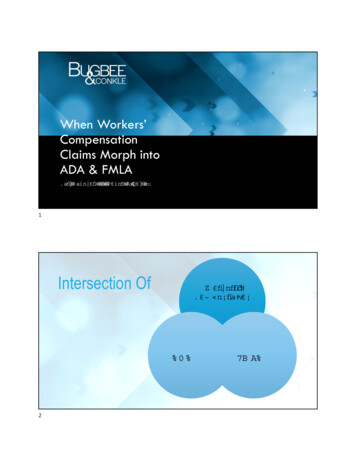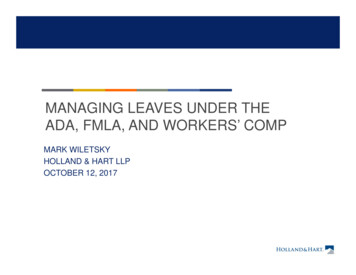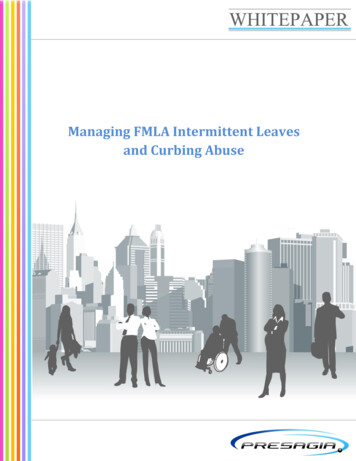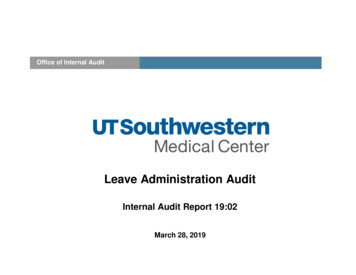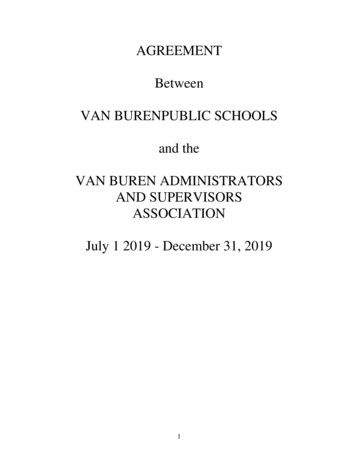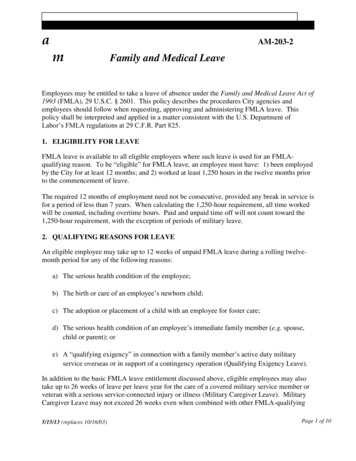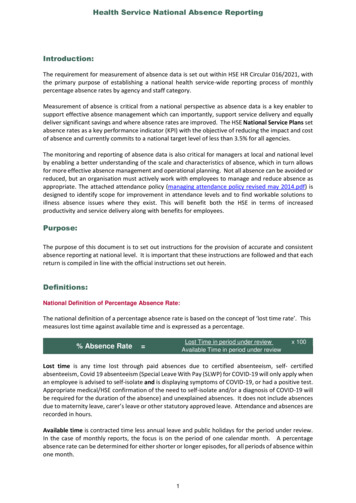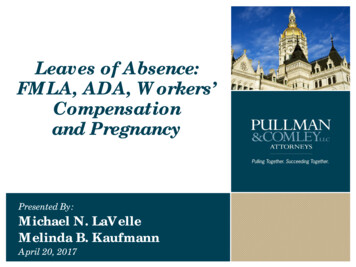
Transcription
Leaves of Absence:FMLA, ADA, Workers’Compensationand PregnancyPresented By:Michael N. LaVelleMelinda B. KaufmannApril 20, 2017
Connecticut FMLA First passed in 1990, Connecticut’s FMLA is very similar, but notidentical, to the federal FMLA. The Connecticut Act grants an employee sixteen weeks of leavein any twenty-four month period – four weeks more than thefederal law, but in a twenty-four month period as opposed to oneyear – to:– (1) deal with their own serious health conditions,– (2) care for certain family members, or– (3) for the birth or placement of a son or daughter with thefamily.Conn. Gen. Stat. § 31-51kk-qq.2 2017 Pullman & Comley LLC
Connecticut FMLA Employers that employ seventy-five or more employees inConnecticut are covered by the CTFMLA. The twenty-four-month period begins on the first day of the leave. Excepted from the CTFMLA are municipalities, local or regionalboards of education or private or parochial elementary orsecondary schools. Eligible employees are those that have been employed by theemployer for at least twelve months and who have worked at least1,000 hours during the twelve months preceding the leave.3 2017 Pullman & Comley LLC
Federal FMLA Passed in 1993, and amended in 2010, the federal FMLA grantsemployees of covered entities twelve weeks of unpaid leave pertwelve month period to:(1) deal with a serious health condition that makes the employeeunable to perform the essential functions of his or her job; or,(2) to care for a spouse, son, daughter, or parent with serious healthconditions, or(3) for the birth or placement (adoption or foster care) of a son ordaughter with the employee’s family.29 U.S.C. §§ 2601(b)(2) and 2612(a)(1).4 2017 Pullman & Comley LLC
Federal FMLA(4) Service Member Leave: An eligible employee may also take up to 26 work weeks of leaveduring a "single 12-month period" to care for a covered servicemember with a serious injury or illness, when the employee is thespouse, son, daughter, parent, or next of kin of the servicemember. This "single 12-month period" for military caregiver leave isseparate from the 12-month period used for other FMLA leavereasons.5 2017 Pullman & Comley LLC
Federal FMLA Employers covered by the Act are those that employ fifty or moreemployees (within 75 miles of each other) for twenty or moreweeks during the calendar year.29 U.S.C. § 2611(4); 29 C.F.R. §§ 825.104-105. An employee becomes eligible for FMLA leave if he or she hasbeen employed by a covered employer for no less than a year andhas worked at least 1250 hours during the preceding twelvemonths.29 U.S.C. § 2611(2)(A); 29 C.F.R. § 825.111.6 2017 Pullman & Comley LLC
FMLA for Paraprofessionals Connecticut has extended the protections of the federal FMLA toparaprofessionals In order to be eligible, the paraprofessional must have worked 950hours in the twelve months prior to commencement of the leave Like the federal FMLA, only hours actually worked, not those forwhich the paraprofessional used paid leave such as sick leave orholidays counts toward the 950 hours Conn. Gen. Stat. §31-51rr7 2017 Pullman & Comley LLC
Federal FMLA An eligible employee may take FMLA leave to care for thefollowing family members:– parents (including individuals who stood in loco parentis to anemployee but specifically excluding parents-in-law),– children (including biological, adopted, foster or stepchildren, legalwards, children for whom the employee is standing in loco parentisand children 18 years old and older who are incapable of self-care)– and husbands or wives.29 C.F.R. § 825.113.8 2017 Pullman & Comley LLC
Federal FMLA –Defining “Serious Health Condition” Both the federal and Connecticut statutes define a “serious healthcondition” as“an illness, injury, impairment, or physical or mentalcondition that involves: (A) inpatient care in a hospital,hospice, or residential medical care facility; or (B)continuing treatment by a health care provider.”29 U.S.C. 2611 (11); Conn. Gen. Stat. § 31-51kk. The regulations demonstrate that the definition of the term“serious health condition” is intended to mean medical treatmentfor a disabling condition that is not a simple broken bone orfleeting illness. So the condition is more than the common cold9 2017 Pullman & Comley LLC
Federal FMLA –Defining “Serious Health Condition” An employee must demonstrate:(1) a "period of incapacity requiring absence from work,"(2) that this period of incapacity exceeded three days, and(3) that the employee received "continuing treatment by . ahealth care provider" within the period.Examples:– Pregnancy or prenatal care– Chronic conditions– Permanent or long-term conditions– Conditions requiring multiple treatments10 2017 Pullman & Comley LLC
Employer Responsibilities Provide notice (§ 825.300 )– Post a General Notice, and– Provide General Notice in employee handbook or, if nohandbook, distribute to new employees upon hire Maintain group health insurance Restore the employee to same or equivalent job and benefits Maintain records Provide Notice of Eligibility§ 825.300
FMLA –Employer Notice Requirements forConcurrent Leave Employers must advise an employee taking FMLA leave whethervacation or other paid leave must be used concurrently with theFMLA leave within two business days (absent extenuatingcircumstances) of its decision to count the time as FMLA leave.– 29 C.F.R. Section 825.208. Employers must give written notice of the designation, along withdetailed information concerning the employee's rights andresponsibilities under the Act, "within a reasonable time afternotice of the need for leave is given by the employee--within oneor two business days if feasible."– § 825.301(c).12 2017 Pullman & Comley LLC
Federal FMLA Returning an Employee to Work Once an employee is able to return from FMLA leave, he or she isentitled to be restored to the same job or an equivalent positionwith the same pay, benefits and duties (or substantially the sameduties pay, benefits, and conditions of employment).– 29 U.S.C. § 2614(a)(1). Reinstatement is required even if the employee has been replacedor his or her position has been restructured to accommodate theemployee's absence.– 29 C.F.R. § 825.214.13 2017 Pullman & Comley LLC
Federal FMLA Returning an Employee to Work An equivalent position must involve the same or substantiallysimilar duties and responsibilities that have equivalent skill,effort, responsibility, and authority as the employee’s previousjob.– 29 C.F.R. § 825.215. A returning employee also is entitled to restoration of the samebenefits that the employee had prior to taking FMLA leave.– Including being restored to a position with the same or equivalent payrate and premiums, including any overtime ordinarily available forthat position and the same or an equivalent opportunity for bonuses,profit sharing, and other similar payments.14 2017 Pullman & Comley LLC
Return to Work Issues Underthe State and Federal FMLAs Under CTFMLA, if the employee is medically incapable ofperforming the duties of the employee’s former job, the employeehas the right to be transferred to a suitable job, if one is available.Sec. 31-51qq-22. However, under FMLA, if the employee is unable to perform anessential function of the position the employee is not entitled toanother position. Therefore, Connecticut employers with less than seventy-fiveemployees, need not consider a job transfer under the state FMLA,but must then evaluate the other laws that may be applicable, suchas CFEPA or ADA.15 2017 Pullman & Comley LLC
Key Employee Exception A covered employer may deny restoration to a “keyemployee” if necessary to prevent substantial andgrievous economic injury to its operations. A key employee is a salaried, FMLA-eligible employeewho is among the highest paid 10% of all employees,both eligible and not eligible, within 75 miles of theworksite.16 2017 Pullman & Comley LLC
Federal FMLA –Employee Notice Requirements While an employee does not have to ask specifically for FMLA leave tomeet the Act’s notice requirements, the employee must notify theemployer “as soon as practicable” of a qualifying reason for FMLA leave.– 29 C.F.R. 825.302; Conn. Regs. § 31-51qq-27 Where the need for leave is foreseeable, the employee should give theemployer thirty days’ notice. Additionally, an employer may require an employee on FMLA leave toreport periodically to the employer on the status and intention of theemployee to return to work. Finally, the employee’s notice must provide the employer with enoughinformation to make clear that the employee’s reason for seeking leavequalifies under the FMLA.17 2017 Pullman & Comley LLC
Federal FMLA – FMLA MedicalCertification Requirements An employer may require an employee who has been on FMLAmedical leave to obtain a certification from a health care providerindicating that the employee is ready/able to return to work. An employer may delay reinstatement until the employeecompletes a fitness-for-duty certification. An employer must tell an employee at the start of the FMLAmedical leave that a fitness-for-duty certification is necessary The fitness-for-duty process must be described in written policies. If an employer decides to require a fitness-for-duty certification,this process must be administered in a consistent manner.18 2017 Pullman & Comley LLC
Federal FMLA –FMLA Medical CertificationRequirements Employers may require medical certification of the circumstancesthat supports the employee’s request for FMLA leave.– 29 C.F.R. 825.305; Conn. Regs. § 31-51qq-30. Employers must give notice each time that they requirecertification. With the employee’s permission, a health care providerrepresenting the employer may contact the employee’s health careprovider seeking clarification and authentication.19 2017 Pullman & Comley LLC
Federal FMLA –FMLA Medical CertificationRequirements The certification should contain information explaining how anemployee’s condition meets the definition of “serious healthcondition.”– 29 C.F.R. § 825.306 (2000); Conn. Agencies Regs. § 31-51qq-31. It should also list when the condition began and how long it isexpected to last, as well as what treatments will be required andwhether it is necessary for the employee to take leaveintermittently or have a reduced work schedule.20 2017 Pullman & Comley LLC
Interplay between FMLA andCTFMLA The state and federal regulations provide that an eligibleemployee must be provided the twelve week federal FMLA leaveeach year. That means that an eligible employee may take sixteen weeks CTFMLA leave in a given year, then an additional twelve weeksleave under FMLA during the next year. But if an employee takes twelve weeks of FMLA leave first, thenthe four weeks of leave under CT FMLA are subsumed within thetwelve during the second year of eligibility and only twenty-fourweeks of leave is available during a two year period.21 2017 Pullman & Comley LLC
S.B. 1 – Earned Family andMedical LeaveReported out of Labor and Public Employees Committee; on Senatecalendar.1.Establishes paid leave for 12 weeks in 12 month period. 2.Family and Medical Leave Compensation Program funded byemployee contributions, starts 7/1/2020.Revises State FMLA FMLA applies to employers with at least 2 employees Employee eligibility based on earnings of 2,375 in highest of fiveprevious quarters Reconciles with federal FMLA – 12 weeks in 12-month period Adds grandchildren Eliminates employer option to change employer-paid leaveconcurrently22 2017 Pullman & Comley LLC
The Americans with DisabilitiesAct (ADA) - Overview Effective in 1992 and amended in 2008, the ADA prohibitsemployers with 15 or more employees from discriminating againsta qualified individual because of a disability.– 42 U.S.C. § 12112. Title I of the ADA prohibits private employers, state and localgovernments, employment agencies and labor unions fromdiscriminating against qualified individuals with disabilities in jobapplication procedures, hiring, firing, advancement,compensation, job training, and other terms, conditions andprivileges of employment. ADA Title III applies to Public Accommodations.23 2017 Pullman & Comley LLC
The American with DisabilitiesAct (ADA) - Overview The ADA focuses on general prevention of discrimination against thedisabled. The provisions of the ADA do not emphasize return to work issues, but atwork issues. Under the ADA employers are under a broad prohibition to not discriminatebecause of a disability. Changes in the terms of employment after an absence that do not reflectreasonable accommodations may constitute discrimination. The principal duty of an employer is its obligation to provide a reasonableaccommodation to a disabled employee. The employer owes this duty to a disabled employee whether or not theemployee has been absent from work.24 2017 Pullman & Comley LLC
CFEPA For employers with less than 15 employees, the Connecticut FairEmployment Practices Act will govern. CFEPA requires reasonable accommodations of disabled andpregnant employees and applicants. CHRO will enforce25 2017 Pullman & Comley LLC
ADA Definitions An “individual with a disability” is a person who:– Has a physical or mental impairment that substantially limitsone or more major life activities;– Has a record of such an impairment; or– Is regarded as having such an impairment.26 2017 Pullman & Comley LLC
ADA DefinitionsA "qualified individual with a disability" is identified as:"an individual with a disability who, with or withoutreasonable accommodation, can perform the essentialfunctions of the employment position that such individual holdsor desires."27 2017 Pullman & Comley LLC
ADA Definitions Under the ADA’s regulations, "substantially limits" means that anindividual is:– (1) Unable to perform a major life activity that the averageperson in the general population can perform; or– (2) Significantly restricted as to the condition, manner orduration under which an individual can perform a particularmajor life activity as compared to the condition, manner, orduration under which the average person in the generalpopulation can perform that same major life activity.28 2017 Pullman & Comley LLC
ADA DefinitionsMajor life activities are activities that an average person can performwith little or no difficulty. Caring for oneself, performing manual tasks, seeing, hearing, eating, sleeping, walking, standing, sitting, ng,reading,concentrating,thinking,communicating, interactingwith others, and working. 29 2017 Pullman & Comley LLC
ADA –Reasonable AccommodationsReasonable accommodation may include, but is not limited to: Making existing facilities used by employees readily accessible toand usable by persons with disabilities. Job restructuring, modifying work schedules, reassignment to avacant position; Acquiring or modifying equipment or devices, adjustingmodifying examinations, training materials, or policies, andproviding qualified readers or interpreters.30 2017 Pullman & Comley LLC
ADA –Undue Hardship The ADA requires that, unless it would cause “undue hardship,”employers must provide “reasonable accommodations” tootherwise qualified employees if those accommodations enablethe employee to perform the essential elements of his or her job orthe job the employee desires.– 42 U.S.C. § 12112 (b) (5) (A). Undue hardship is defined as an action requiring significantdifficulty or expense when considered in light of factors such as anemployer's size, financial resources and the nature and structureof its operation.31 2017 Pullman & Comley LLC
ADA - The “Interactive Process”Between Employer and EmployeeOver Reasonable Accommodations Under the ADA, when a disabled individual requestsaccommodation, the employer and employee must engage in an“interactive process.” They both have a duty to act in good faith and assist in the searchfor appropriate reasonable accommodations. Failure to participate in the interactive process is demonstrated by– 1) the employer’s knowledge of the disability,– 2) the employee’s request for accommodation,– 3) the employer’s lack of a good faith effort to find an accommodation,and– 4) the existence of a situation where accommodation would have beenpossible “but for the employer’s lack of good faith.”32 2017 Pullman & Comley LLC
ConnecticutWorkers’ Compensation Act Our Workers’ Compensation laws are primarily designed tocompensate employees for losses resulting from injuries and illness“arising out of and in the course of (their) employment.”– Conn. Gen. Stat. § 31-275(1). However, two statutory provisions protect an employee’s right toreturn to a job after suffering a compensable injury:– Conn. Gen. Stat. §31-313 requires that when, as a result of acompensable injury, the employee can no longer do his or her regularjob, the employer must transfer him or her to a suitable full-timeposition until the employee’s medical treatments have terminated orthe employee’s recovery has reached its limit, if such work is available.– Conn. Gen. Stat. §31-290a prohibits discrimination against anemployee for asserting rights under the Workers’ Compensation Actand permits reinstatement of an employee wrongfully denied aposition.33 2017 Pullman & Comley LLC
FMLA v. Connecticut Workers’Compensation Act v. ADAReturn to Work Issues If an employee exhausts a period of leave under the FMLA(remains totally disabled for longer than 12 or 16 weeks) and stillcannot return to his job due to a disabling work-related injury, theemployee’s right to job retention under the FMLA ceases with theinability to return to work. Moreover, the employer may be permitted to terminate theemployee’s employment after a certain period of total disability –so long as no reasonable accommodation exists and the employerhas a clear policy relating to the termination of employment insuch a situation. The employer has the right to uniformly apply an explicit,reasonable, absence control policy by terminating an employee onextended disability leave.34 2017 Pullman & Comley LLC
EEOC Enforcement Guidance onPregnancy Discrimination andRelated Issues The Equal Employment Opportunity Commission’s EnforcementGuidance on Pregnancy Discrimination and Related Issues is thefirst comprehensive update on the subject since 1983. It supersedes earlier guidance (Section 626: Pregnancy, EEOCCompliance Manual, Volume II; Policy Guidance on the SupremeCourt Decision in International Union, United Automobile, Aerospace &Agricultural Implement Workers of America, UAW v. Johnson Controls,Inc.) (1991)). The EEOC also has a related “Q&A” document and Fact Sheet forSmall Businesses.35 2017 Pullman & Comley LLC
EEOC Enforcement Guidanceon Pregnancy DiscriminationThe Guidance’s more controversial requirements include thefollowing:1. an employer policy of providing light duty only to employeeswith on-the-job injuries violates the PDA;2.an employer must provide accommodations to an employeewith a normal and otherwise healthy pregnancy;3.certain employer inquiries, comments or discussions regardingan employee’s pregnancy or potential pregnancy are indicativeof discrimination; and4.an employer health insurance plan must cover prescriptioncontraceptives on the same basis as prescription medicationsthat prevent medical conditions other than pregnancy.36 2017 Pullman & Comley LLC
Light Duty, Accommodations,InquiriesThe EEOC Guidance addresses circumstances under whichemployers may have to provide light duty to pregnant workers: An employer may not refuse a pregnant worker’s request for lightduty based on a policy that makes distinctions based on the sourceof an employee’s limitations (e.g., a policy of providing light dutyonly to workers injured on the job or to workers with an ADAcovered disability). A pregnant worker needing light duty is equivalent to a workerneeding light duty due to on-the-job injuries or ADA-covereddisabilities because of the ability or inability to work.37 2017 Pullman & Comley LLC
Light Duty, Accommodations,Inquiries Until this EEOC Guidance was issued, the PDA had beeninterpreted to mean pregnancy is not a disability under the ADA. However, the EEOC Guidance states that to the extent a worker’snormal, healthy pregnancy limits her ability to perform certain jobduties, and to the extent an employer would accommodate anemployee with similar limitations, the employer must alsoaccommodate the pregnant worker or risk discriminating againstthe woman on the basis of her pregnancy. This is not necessarily consistent with existing case law.38 2017 Pullman & Comley LLC
Light Duty, Accommodations,InquiriesThe EEOC also declared that certain employer inquiries related topregnancy or potential pregnancy are indicative of discrimination.In the Q&A document, EEOC states, “Although Title VII does notprohibit employers from asking applicants or employees aboutgender-related characteristics such as pregnancy, such questions aregenerally discouraged.The EEOC will consider the fact that an employer has asked such aquestion when evaluating a charge alleging pregnancydiscrimination.”39 2017 Pullman & Comley LLC
2017 Pullman & Comley LLC
Contact InformationMichael N. LaVellePullman & Comley, LLC850 Main Street, P.O. Box 7006Bridgeport, CT 06601Tel: (203) 330-2112Email: mlavelle@pullcom.comMelinda B. KaufmannPullman & Comley, LLC90 State House SquareHartford, CT 06103Tel: (860) 424-4390Email: mkaufmann@pullcom.com41 2017 Pullman & Comley LLC
BRIDGEPORT HARTFORD STAMFORDwww.pullcom.com WATERBURY WHITE PLAINS
FMLA, ADA, Workers' Compensation and Pregnancy Presented By: Michael N. LaVelle Melinda B. Kaufmann April 20, 2017. Connecticut FMLA First passed in 1990, Connecticut's FMLA is very similar, but not identical, to the federal FMLA. The Connecticut Act grants an employee sixteen weeks of leave
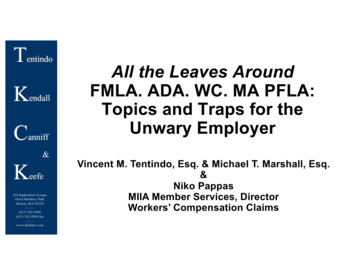
![FMLA Time Types and Leave Code Powerpoint-mw [Read-Only]](/img/56/fmla-time-types-leave-code-110612.jpg)
